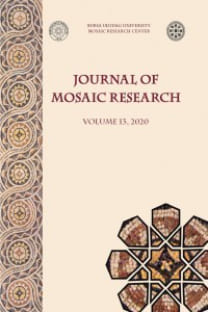Written and Visual Culture About the Mosaic of Castulo: The Influence of Lucian's Works
Castulo Mozaiği Hakkında Yazılı ve Görsel Kültür: Lucian'ın Çalışmalarının Etkisi
___
- Albertini 1920 E. Albertini, "Mosaïque à figures trouvée à Cherchel", BCTH: CLXXIII-CLXXV.
- Albertini 1921 E. Albertini, "Mosaïques et inscriptions romaines trouvées à Cherchel, BCTH: LXXVIII-LXXIX.
- Balty 1977 Janine Balty, Mosaïques antiques de Syrie. Bruselas.
- Baratte 1978 François Baratte. Catalogue des mosaïques romaines et paléochrétiennes du musée du Louvre. Paris.
- Bazant 1994 Jan Bazant, s.v. Pothos I, LIMC VII,1/2. Zürich, München, Düsseldorf: Artemis & Winkler Verlag.
- Blanchard Lémée et al. 1995 Michèle Blanchard-Lemée - Gilles Mermet - Mongi Ennaifer - He?di Slim - L Slim, Sols de l'Afrique Romaine,Paris.
- Blázquez 2014 José M. Blázquez, "Mitos del mosaico de Castulo", 7esquinas. Boletín del Centro de Estudios Linarenses 6:109-116.
- Blázquez et al. 1993 José M. Blázquez - Guadalupe López - Luz Neira - Mª Pilar San Nicolás, "Hallazgos de mosaicos romanos en Hispania (1977-1987)", Espacio, Tiempo y Forma: 279.
- Chaparro 2000-2002 César Chaparro, "Mito, texto e imagen: El mito de Selene y Endimión", Excerpta philologica. Revista de filología griega y latina de la Universidad de Cádiz, núm. 10-12: 231-257.
- Damisch 1996 Hubert Damisch, El Juicio de Paris: Iconología Analítica, México: Siglo XXI.
- de Matteis 1999 Lorella Maria de Matteis, "I mosaici romani dell'area delle Terme occidentali», CMGR VII, Túnez: Institut National du Patrimoine, 59-67, pl. VIII, 4-IX, 1.
- de Paco 2006 Diana de Paco, "La Crestomatía de Proclo y la tradición poética y retórica", Calderón, E. et al. (eds.). KOINÒS LOGOS. Homenaje al profesor José García López, Murcia: 737-745.
- Fantar et al. 1994 Mohamed Fantar - Paul Veyne - Salah Jaber et al., La Mosaïque en Tunisie, Paris.
- Gabelmann 1986 Hanns Gabelmann, s.v. "Endymion", LIMC III, 1/2, Zürich, München, Düsseldorf, Artemis & Winkler Verlag.
- Gury 1994 François Gury, s.v. "Selene", LIMC VII, 1/2, Zürich, München, Düsseldorf, Artemis & Winkler Verlag.
- Kossatz-Deissmann 1994 A. Kossatz-Deissmann, s.v. "Paris Iudicium", LIMC VII, 1/2, Zúrich-Munich, Artemis Verlag.
- Lancha 1997 Janine Lancha, Mosaïque et Culture dans l'Occident romain (Ier.-IVe . S.). Roma: L'Erma di Bretschneider.
- Lledó 2011 José Luis Lledó, "Mujeres, mitos y arquetipos femeninos en los mosaicos romanos en Noheda", L. Neira, coord. & ed. Representaciones de mujeres en los mosaicos romanos y su impacto en el imaginario de estereotipos femeninos. Madrid: CVG, 225-238.
- López 2014 Guadalupe López, "El mosaico de los "Amores" de Castulo", 7esquinas. Boletín del Centro de Estudios Linarenses 6: 117- 126.
- López - Neira 2010 Guadalupe López - Luz Neira, "Mosaico", in P. León, coord. Arte Romano de la Bética III, Madrid: Ediciones El Viso, 107-109, 133-134.
- Neira 2009 M. Luz Neira, "La imagen como documento para el estudio de las elites en el Imperio Romano", Estudos Da Lingua(Gem) 7: 11-53.
- Pace 1955 Biagio Pace, I mosaici di Piazza Armerina. Roma: Gherardo Casini Editore.
- Pedrosa 2014 Arias Pedrosa, Ogayar, "Castulo en movimiento. Primer avance del proyecto FORVM MMX", 7 esquinas,Boletin del Centro de Estudios Linarenses, V, núm. 6.
- Severyns 1950-51 A. Severyns, "Pomme de discorde et jugement des dèsses", in Mélanges Joseph Hombert, Phoibos, v, fasc. 1 y 2, Bruselas: 145-172.
- Stern 1963 Henri Stern, Recueil Génerale des Mosaïques de la Gaule I, 3. Belqique. Parte sud. París: Supplément à Gallia:P. 61, Núm. 314 A, lám. XXVIII, c.
- ISSN: 1309-047X
- Yayın Aralığı: 1
- Başlangıç: 2008
- Yayıncı: Ululdağ Üniversitesi, Mozaik Araştırlmaları Merkezi
Looking at Two Patterns Inspired in Coffered Ceilings: Some Examples in the Portuguese Roman Mosaics
The Basilica Mosaic on Asar Island at Myndos
Before the Corpus: Byzantine Mosaics in Istanbul in Nineteenth-Century French Guide-Books
The Orpheus Mosaic of Prusias ad Hypium
Written and Visual Culture About the Mosaic of Castulo: The Influence of Lucian's Works
